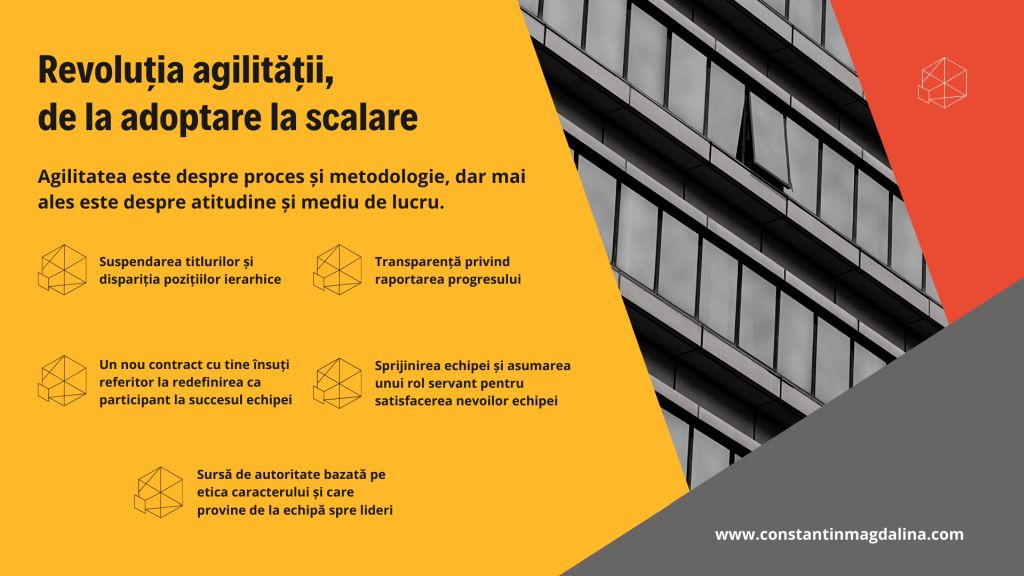
When we hear the word "agile" today and how it is used in companies, we generally think about the speed in delivering what we do. It is one of the most popular approaches for companies that want to do things fast and be more adaptable.
For many people, agile means just teamwork to get the job done quickly and easily. This may already be happening in some parts of the company. Having a few teams "working in an agile way" can facilitate speed in the right conditions, but doing this on a company-wide scale is very different.
Agile, understood as a framework, is much broader than the fact that teams accelerate the execution of their projects. To scale agility, the basic backbone of the organization needs to change. Adjustments to the company's vital processes, such as decision-making, business planning, and risk management throughout the organization, need to be aligned with a new way of working.
Product development teams are facing a silent revolution that engineers and managers must adapt to. Every industry is driven by customer demand for continuous innovation and lower testing costs. It is a signal of an important transition from anticipatory to adaptive development styles. This change makes it difficult for engineers, project managers, and managers who still operate with prescriptive, prescriptive mentalities and processes valid for a period of stability that has disappeared.
In the agile approach, the more you advance in planning the future, the more unpredictable the results. New regulations, new competitors, new technologies, and new market realities can come at any time. The agile approach designs any project with a quick and easy start, called the Minimum Viable Product (MVP), to discover what is important to add afterward. The agile approach also argues that it is more efficient to build only what is needed and in order of priority, regardless of when the change in requirements or priority is recognized. The agile framework requires the separation of roles, as the business is only allowed to manage and prioritize "WHAT", and developers are solely responsible for "HOW".
For over 10 years, startups and web development teams have been following agile software development methods. The pandemic crisis has forced governments, companies, and even organizations in highly regulated environments to adopt agility. Uncertainty, short response times, and the need for iterative exploration to validate solutions have highlighted the benefits of an agile approach.
Anticipatory approaches to project management have failed because long-term planning does not take into account the fluid economic reality we live in. Agility scores decisively in response to change due to short cycles of planning, implementation, testing, and actuating. As product development processes move from anticipatory to adaptive, project management also changes. It is shifting focus on mobility, experimentation, and speed. But first, it is business-oriented.
Not only the project management is changing, but also the way of leading, the leadership is changing regarding aspects such as:
1. Suspension of titles and of hierarchical positions behind which to hide or defend
2. Transparency in progress reporting
3. Team membership and a new personal contract with yourself regarding redefining as a participant in the team's contribution
4. Support the team and play a servant role in meeting the needs of the team, and
5. The source of authority is based on character ethics and comes from the bottom up.
Agility is about process and methodology, but especially about attitude and work environment. Adopting a set of practical key elements set out in rule-generating principles is very important for the successful implementation of agility. These key practical elements are:
1. Ensure transparency and visualization - Work efficiently and clearly by articulating vision and values, MVPs, and OKRs (Objectives and Key Results). The same goes for communication in Teams, Jira, Confluence, etc. Transparency means more than sharing information: it means being responsible in collaboration, for a common understanding of the context, objectives, and tasks to be performed.
2. Get into the loop, stay in the loop - When it comes to iterations, it's all about cycles. It doesn't matter what framework you use. As long as the team has measured its performance, it will continuously improve, it will add value to colleagues in the organization, customers, stakeholders, and consumers.
3. Use Time Boxing - This is a quick way to learn how to focus and make the most of a certain amount of time. The method involves defining time intervals for each segment of a meeting. However, no extreme rigor is required. Always be aware that time is an essential and limited resource.
4. Rely on the MVP - The idea of an MVP is to find the first working solution to the main problem of the customer/user of a product. The scope will be reduced to the level where the product brings sufficient quality to the customer while limiting the risks and reducing the time to market. It is essential that you learn about MVP as soon as possible.
5. Maintain the cycle of action and reflection - The generic model of an agile mode of work is defined by alternating the phases of concentrated action ("Plan and Do") and relaxed reflection ("Check and Actuating"). This approach creates a learning company. To do this you need to set up a retrospective review session in your team's calendar and take the time to think about what can be done better.
About Constantin Magdalina
Constantin Magdalina has 15 years of working experience, while he performed in multinationals both in Romania and abroad. Constantin has a master’s degree in Marketing and Business Communication from the Academy of Economic Studies in Bucharest. He is certified in Lean Six Sigma and ITIL which provide him a good understanding of processes and transformations within organizations. The Chartered Institute of Marketing certification further complemented his expertise and knowledge in business. In those over 4 years of working activity in a Big4 company, he initiated and conducted studies that analyzed different aspects related to the business environment in Romania such as the economic growth predictions of companies in 2013-2016, knowledge management, the buying experience in the age of digital consumers, social media 2013-2015, the utilization of mobile devices in Romania. He is the author of numerous articles on topics related to innovation, the efficiency of business processes, social media, the consumers’ buying experience in the age of digital, trends, and emergent technologies. He is invited as a speaker at numerous events and business conferences.





























